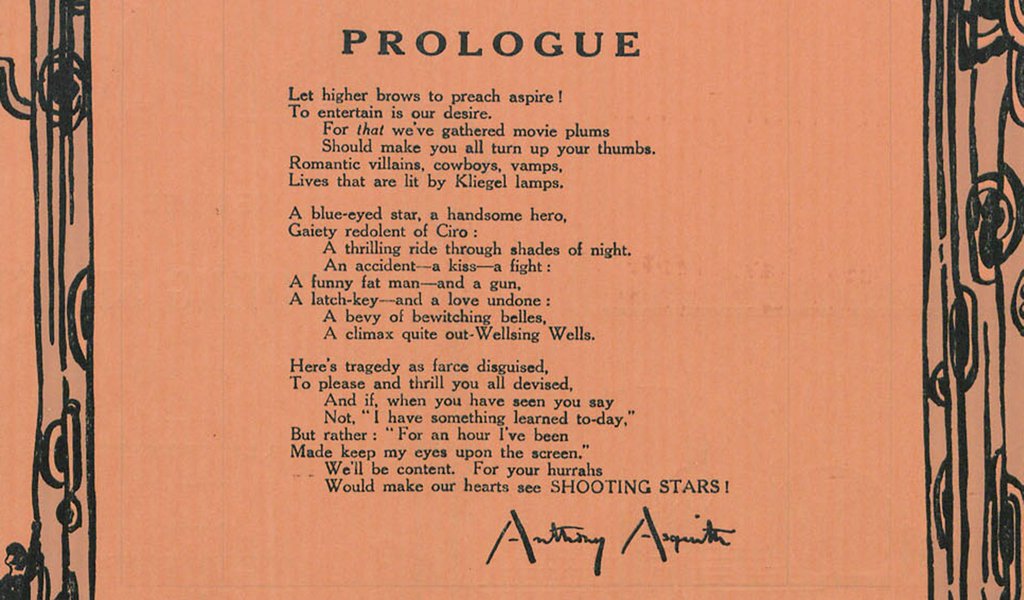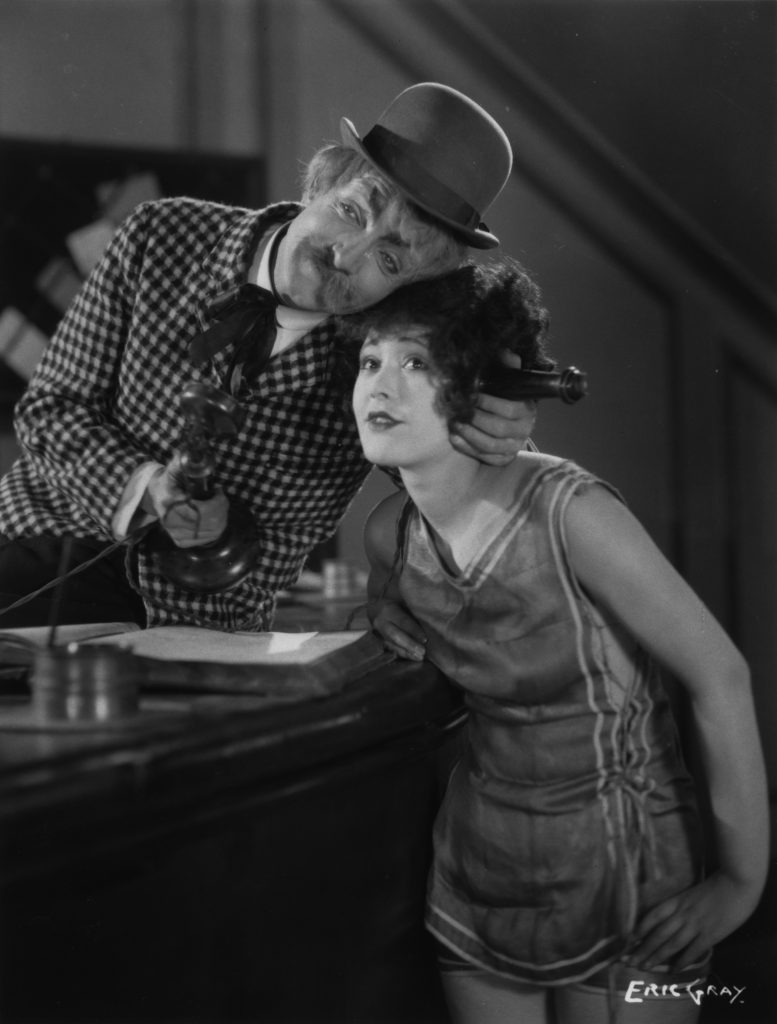Giveaway: Win BFI Blu-ray/DVD Sets of Anthony Asquith’s Shooting Stars!
- Following the British Film Institute’s acclaimed restorations of wunderkind British director Anthony Asquith’s Underground (1928) and A Cottage on Dartmoor (1929), it’s the turn of his first feature, Shooting Stars (1928)
- Rebecca Harrison casts her discerning eye over their new Blu-ray/DVD set
I first saw Anthony Asquith’s ‘blue-eyed star’ Mae Feather and ‘handsome hero’ Julian Gordon at the London Film Festival’s Archive Gala back in October 2015. In a packed Leicester Square cinema the audience laughed and gasped during the BFI’s wonderful restoration of Shooting Stars, a genre-bending film perfect for a big-screen, orchestra-accompanied experience.
Featuring incredible cinematography, dramatic lighting and a storyline to die for, you have to remind yourself continuously that this was Asquith’s directorial debut – although he was uncredited at the time and overseen by studio staple A. V. Bramble. What’s more, watching Shooting Stars again on Blu-ray, I was struck by the film’s freshness, as you could mistake this for a contemporary movie about the cinema industry (the obvious comparison being 2011’s The Artist). In part, the restoration work is responsible for the film’s modern aesthetic. However, the story’s playful self-reflexivity and camera work also play a role in addressing you in the present, rather than the past, tense.
As the BFI’s press release suggests, Shooting Stars adopts an Expressionist style, which translates onscreen as high-contrast lighting and spectacular camera angles that soar up and down into the far corners of the fictional film studio. In one especially memorable sequence, Mae and her lover (the comic, Chaplin-esque actor Andy Wilkes) slip in and out of the gloom in his apartment as cigarette smoke blooms and billows from an ashtray. Backlit by the streetlights beyond the window, the atmospheric scene is cut with images of jilted husband Julian home alone, and tension is exacerbated by the glow from a neon sign opposite Andy’s announcing a new film: ‘Mae Feather in My Man’. As in Hitchcock’s The Lodger, there are shadows lurking behind London’s electric façade, and the contrasts between interior and exterior lights create extraordinary depth onscreen.
The film’s great achievement is the relentlessly mobile camera, which pans, tilts, tracks and dollies throughout: every time the action settles in one place, the camera shifts again to disorient your perspective. In the accompanying notes for the Shooting Stars Blu-ray/DVD set, The BFI’s Bryony Dixon quotes the scenarists’ demands for ‘novel camera angles’ and a ‘modern form of technique’. The result is innovative motion that made me play one sequence over and over to marvel at the intricacies of the cinematography. In the cavernous Cricklewood Studio, the camera looks down at the actors and craftsmen striking a set, tracking their movements and tilting to follow Mae as she goes to her dressing room. Eventually, the camera rests on another stage in an extreme long shot that considerably expands our view of the studio. Then, surpassing expectation, the camera moves again, panning across the set to reveal the enormous scale of Andy’s slapstick comedy production. The travelling shot’s scope is daring; however, what the camera shows us is mundane. As Chris O’Rourke’s essay in the accompanying booklet attests, the 1920s British film industry was not a glitzy place to work. Thus the graceful, omniscient camera simultaneously exposes the hard work that takes place behind the scenes, and the means by which the illusion of glamour is constructed.
Together, the lighting, the cinematography and the stylised design contribute to the film’s Expressionist aura. However, there are other influences at play. Henry K Miller’s contribution to the Shooting Stars literature asserts that Asquith had closer ties to US than European cinemas, for while the filmmaker visited German studios and was knowledgeable about the Swedish film industry, he declared Hollywood ‘the best in the world.’ Asquith is known to have visited the sets of both Charlie Chaplin and Douglas Fairbanks before making Shooting Stars, and Miller also mentions that the film opened at the Plaza on Lower Regent Street in London – usually a venue reserved for ‘major American pictures’.
In the Hollywood tradition, the movie is slick and has high-production values, and while the pace does slow about halfway through the film (when Andy’s comedy relocates to the beach), the action picks up in a suspenseful sequence in Mae and Julian’s apartment. Shooting Stars also shares stylistic similarities with Hitchcock’s British output in the 1920s (such as Blackmail or Number Seventeen). And, as Christine Gledhill argues, the film fits into the melodramatic tradition that informed a great deal of British filmmaking at the time. That is not to suggest that the movie’s Hollywood and British elements detract from its Expressionist antecedents. Instead,the pick ’n’ mix pastiche gives Shooting Stars a post-modern sensibility, which is what makes the film feel so contemporary.
Enhancing the illusion is John Altman’s new score, which gives the movie a characterful voice that carries you across shifting sets and genres along with the camera. I loved the blowsy, Cab Calloway-like swing of brass that accompanies Andy’s appearances, juxtaposed with upbeat percussion and strings during more light-hearted scenes.In addition to the score’s aural clarity, the picture is a brilliant example of visual storytelling. The intertitles are limited to minimalist dialogue and innovative subtitling, with the words of a radio broadcast flashing across the gramophone, and text-based props that propel the narrative forward. For example, we see movie-business ephemera that include contracts, newspaper headlines and call sheets, which not only tell us what is happening onscreen, but also let us into the secrets of film history.
By featuring fans waiting for actors’ autographs, journalists recording interviews, extras in the studio canteen reading Picturegoer, and a cinema audience reacting to a Mae Feather melodrama, the narrative incorporates a wide variety of cinema cultures. As such, Shooting Stars does not favour the actors, but explores the movie industry’s different production, exhibition, and reception contexts. Indeed, the dramatic irony of the beach stunt scene (when the audience are privy to a cast switchover that the newspaper reporters are not) actually privileges the Shooting Stars viewers over the typically more knowing film journalists.
Of course, the more knowing insights given by contributors to the film’s accompanying booklet are very welcome. Dixon examines scenario notes and archival materials, while Altman gives a fascinating overview of his approach to layering 1920s jazz and dance music in the score.Miller describes influences on Asquith’s work, and O’Rourke offers an intriguing glimpse at actors’ lives in the 1920s British film industry. Alongside the extras, which include a brilliant newsreel selection, such as Pathé’s Screen Beauty Competition and Opening of British Instructional Film Studio, the essays provide further behind-the-scenes perspectives and excellent historical context.
However, while there is a brief explanation of the restoration process in the booklet, it would have been interesting to find out more about it as a special feature in the extras. At the London Film Festival screening, the audience was treated to insider information that described how the BFI returned the film to its current, luminescent glory, and I had hoped for something similar on the Blu-ray release.
Shooting Stars: BFI London Film Festival Archive Gala Highlights
Nevertheless, Shooting Stars is a must-see for early cinema fans and anyone interested in film history. As Julian’s church-based production in the closing sequence suggests, the movie is about the cult of cinema and all those who worship in the auditorium. But rather than bow down at the altar, the film remains playfully aware of the medium’s power to suspend disbelief, for as the camera pulls back to expose the church as a studio, Shooting Stars once again reveals the artifice behind the sets, the shoots and the stars.
Shooting Stars BFI region 0 Blu-ray/DVD dual format edition special features
- Pathé’s Screen Beauty Competition (1920, 2 mins)
- Around the Town: British Film Stars and Studios (1921, 2 mins)
- The Lovely Hundred (1922, 25 secs)
- Secrets of a World Industry – The Making of Cinematograph Film (1922, 8 mins)
- Meet Jackie Coogan (1924, 11 mins)
- Starlings of the Screen (1925, 15 mins)
- Opening of British Instructional Film Studios (1928, 4 mins)
- Stills and Special Collections Gallery (2016, 6 mins)
- Original screenplay (downloadable PDF, DVD only)
- Illustrated booklet with essays by Bryony Dixon, John Altman, Henry K Miller and Chris O’Rourke, and full film credits
UK | 1928 | black and white | 101 minutes | silent with music | original aspect ratio 1.33:1
- Disc 1: region 0 BD50 | 1080p | 24fps | DTS-HD Master Audio 5.1 surround, 2.0 PCM stereo
- Disc 2: region 0 DVD9 | PAL | 25fps | Dolby Digital 5.1 surround | Dolby Digital 2.0 stereo
Also coming April 2019 from Kino in the US, on region A Blu-ray and R1 DVD. Unfortunately though, in terms of extras the Kino loses everything but the picture gallery. As the BFI is region free, it’s the one to own.
Images © British Film Institute
Asquith Misterioso: Notes on Anthony Asquith – Jack Miller











Thanks for the review, excellent insights. This BFI Blu-ray was a blind buy for me a couple of weeks ago. I watched it soon after it arrived in the mail and I loved it! The Hithcockian elements were definitely there, as Dr. Harrison said. This was one of those movies that I looked forward to seeing again as soon as it ended- for me, that’s the mark of a great film!